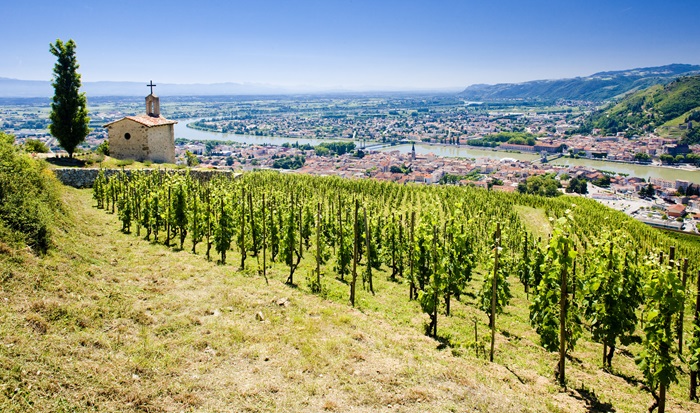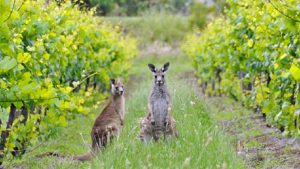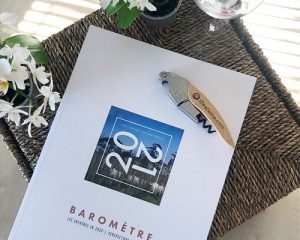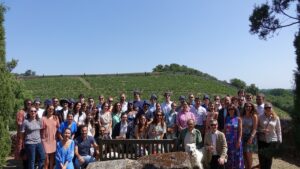
In the prestigious northern Rhône Valley lies an equally prestigious appellation that is the subject of frenzied searches among lovers of powerful yet refined, complex wines crafted for long-term cellaring. We are, of course, talking about the Hermitage appellation, which can sometimes be seen with the alternative spelling of Ermitage. We’ll go into further detail about the reasons behind this in this article.
The origins and history of the Hermitage appellation
The Hermitage appellation in the northern Rhône Valley has a rich historical past. For those of you who know French geography, it’s located the north of Valence in the Drôme department Hermitage wines were already greatly enjoyed by the Romans who referred to them as ‘vins de Vienne’ (along with those from Côte-Rôtie). They were later known as ‘vins du coteau de Saint-Christophe’ (wines from the Saint-Christophe slope), owing to the presence of a chapel dedicated to this holy man. It is thought that the name Hermitage was first coined in the 17th century to commemorate Henri Gaspard de Sterimberg, a knight who, after returning from the Crusades in the 13th century, was tired of fighting and lived as a hermit on this hill donated by Blanche de Castille, Queen of Spain. He is said to have re-established a vineyard there, which has since been successively known as Ermitage and ‘Hermitage’.
The appellation was officially established in 1937 and boasts an illustrious and incomparable list of amateurs including the French king Henri IV, the French poet Boileau, Louis XIII and particularly by Louis XIV, Nicolas II, and Alexandre Dumas along with others.
Ermitage or Hermitage, what’s the correct spelling?
Ermitage without the ‘h’ is the historic name of the appellation. However, as trade with the United Kingdom developed in the 19th century, the name became difficult for France’s British neighbours to pronounce. Her Majesty’s subjects were granted the addition of the ‘h’, which was enshrined in the appellation’s decrees to quash any linguistic claims. Some estates have nevertheless retained the original spelling of the word, in most cases using it for their most prestigious cuvées.
Hermitage, an exceptional terroir behind exceptional wines
Comprising red and white grape varieties, the Hermitage appellation stretches across 135 hectares within the communes of Tain-l’Hermitage, Crozes-Hermitages and Larnage, in the Drôme department, on the left bank of the Rhône River. The vines benefit from different soil influences depending on their geographical location. The soil on the gentle slopes contains clay, which is ideal for growing white grape varieties such as Roussanne and Marsanne. The western part, however, is characterised by steep granite soils ideal for planting the red Syrah grape variety, with the central part producing sunnier wines. This is because rolled pebbles cover the limestone and siliceous rocks. These pebbles, like those found in Châteauneuf-du-Pape in the southern Rhône Valley, store up the heat of the day and release it back into the vines at night, allowing the grapes to reach a good level of ripeness. The vines need these pebbles as, despite the Mediterranean influences and plenty of sunshine in the region, the Mistral wind blows through strongly and (very) coldly, with a little less power in the south, where the signature wines have exceptional ageing potential.
We already briefly mentioned the grape varieties grown here. Representing the vast majority of the vines in the appellation (almost 70%), the reds are produced from Syrah, with an occasional proportion of white grapes which may not exceed 15% of the blend. These include Marsanne and Roussanne, which are, of course, used for the white wines.
The full-bodied, fleshy red wines of the Hermitage appellation display a deep, intense ruby colour, and develop an incredible wealth of aromas characterised by notes of violets, spices and blackcurrants. These wines offer exceptional ageing potential, and the best vintages acquire greater finesse and harmony over time. White Hermitage wines, produced from Marsanne and Roussanne grapes, develop creamy, honeyed aromas of hazelnuts, peach and apricot with a rare unctuousness on the palate. Their ageing potential is measurable in decades.
The Hermitage slopes listed as a national heritage site
The slopes of Hermitage were listed as a national heritage site on 5 June 2013, and are as such a protected ‘designated picturesque and historic site’. The Hermitage Hill and its slopes are known the world over for their terraced vineyards. For a time, the slopes were under threat of being altered by the erection of an 18-metre-high telephone aerial. Thankfully, this project never came to fruition and this splendid landscape, one of the treasures of France’s winegrowing regions, remained intact.
A very distinctive visual landmark, the vines stretch across the entire south and east-facing hillside, with their lines clearly visible in the landscape. At the foot of the hill, on either side of the river, lay the towns of Tain-l’Hermitage on the left bank and Tournon on the right bank. In addition to this highly unusual geographical location, the Hermitage Hill is of great scenic and historical interest owing to its terraced layout, which can be seen from the railway line and the road, and whose geometric display, in addition to its agricultural purpose, also appeals to the eye and captures the attention of the traveller.
Hermitage, a Protected Appellation Designation
In the wake of the scandal caused by a Californian so-called ‘Champagne’ being served at Barack Obama’s investiture lunch, the Hermitage winemakers took a stand in 2013. They appealed to the relevant authorities to put an end to the use of the ‘Ermitage’ brand on Californian sparkling wines. As far as they are concerned, ‘with or without an H’, this appellation ‘is entirely bubble-free’.



